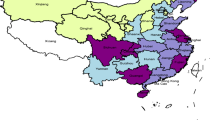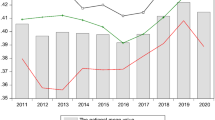Abstract
Based on emergy theory, this paper calculates the agricultural green GDP of China and its provincial units from 2003 to 2018. Following this, the spatial distribution characteristics and influencing factors of the economic growth of green agriculture in China are studied using the spatial analysis method. The results show that: (1) Compared with the traditional GDP derived from agriculture, the per capita green agriculture GDP growth in China is relatively slow, and the proportion of green agriculture GDP to the traditional GDP from agriculture is between 85 and 91%, which shows a downward trend. (2) The economic growth of China's green agriculture manifests significant spatial agglomeration, with gradually growing effects. (3) The per capita GDP of green agriculture has not broken the overall pattern of high economic growth in China’s eastern regions and low growth in the western. According to the results, the major cause of this spatial pattern lay in the higher efficiency of agricultural production in the eastern, economically more developed areas, and the relatively less efficient mode of production in the western areas. (4) A region’s level of economic development, technological innovation, infrastructure investment and openness were found to have a positive impact on the growth of green agriculture within it. In previous research, emergy methods have not been applied to study the economic sectors in China, the largest developing country in the world, especially in the agricultural sector. Only few studies report on the analysis of spatial characteristics and factors influencing the growth of green agriculture. The agricultural green GDP was calculated based on the emergy analysis method. The temporal and spatial characteristics, as well as the driving factors of green agriculture GDP, were analyzed under the full consideration of the spatial correlation, which contributes to the theoretical explanation of spatial agglomeration of economic factors in spatial economic theory. The conclusions provide a theoretical and practical basis for accurate evaluation of the green growth of China's agricultural economy, optimization of the spatial structure of the country’s green agricultural economy and coordination of the development of green agriculture in different regions.




Similar content being viewed by others
References
Anselin, L. (2013). Spatial econometrics: methods and models (Vol. 4). Springer Science & Business Media.
Chen, F. (2004). Agricultural ecology. China Agricultural University Press.
Chen, Y.-h, Wen, X.-w, Wang, B., & Nie, P.-y. (2017). Agricultural pollution and regulation: How to subsidize agriculture? Journal of Cleaner Production, 164, 258–264. https://doi.org/10.1016/j.jclepro.2017.06.216
Chen, W., et al. (2018). An emergy accounting based regional sustainability evaluation: A case of Qinghai in China. Ecological Indicators, 88, 152–160. https://doi.org/10.1016/j.ecolind.2017.12.069
Chen, D., Zhang, P., Luo, Z., Cao, X., & Wang, W. (2019). Discussion of the study on sustainability of land resources in Dengkou County based on emergy analysis. Journal of Cleaner Production, 206, 724–726. https://doi.org/10.1016/j.jclepro.2018.09.230
Cheng, H., Chen, C., Wu, S., Mirza, Z. A., & Liu, Z. (2017). Emergy evaluation of cropping, poultry rearing, and fish raising systems in the drawdown zone of Three Gorges Reservoir of China. Journal of Cleaner Production, 144, 559–571. https://doi.org/10.1016/j.jclepro.2016.12.053
Franzluebbers, A. J., Lemaire, G., de Faccio Carvalho, P. C., Sulc, R. M., & Dedieu, B. (2014). Toward agricultural sustainability through integrated crop-livestock systems: environmental outcomes agriculture. Ecosystems & Environment, 190, 1–3. https://doi.org/10.1016/j.agee.2014.04.028
Geng, Y., Zhang, P., Ulgiati, S., & Sarkis, J. (2010). Emergy analysis of an industrial park: The case of Dalian. China Science of The Total Environment, 408, 5273–5283. https://doi.org/10.1016/j.scitotenv.2010.07.081
Graff Zivin, J., & Neidell, M. (2012). The impact of pollution on worker productivity. American Economic Review, 102, 3652–3673. https://doi.org/10.1257/aer.102.7.3652
Guo, L. Y., Lei, M., & Liu, X. Q. (2015). Green GDP accounting research based on emergy analysis method:a case study of shangluo city in Shanxi province. Journal of natural resources, 30, 1523–1533. https://doi.org/10.11849/zrzyxb.2015.09.009.
Hansen, M. H., Li, H., & Svarverud, R. (2018). Ecological civilization: Interpreting the Chinese past, projecting the global future. Global Environmental Change, 53, 195–203. https://doi.org/10.1016/j.gloenvcha.2018.09.014
He, L. Y., Zhang, L. H., & Zhong, Z. Q. (2019). Green credit, renewable energy investment and green economy development, Empirical analysis based on 150 listed companies of China. Journal of Cleaner Production, 208, 363–372. https://doi.org/10.1016/j.jclepro.2018.10.119
HoATEE, B. (1984). Handbook of agricultural technology economics. Agriculture Press.
Huang, A. S., Xu, J. X., Liu, Z. B., Huang, S. W., & Wang, Q. Q. (2014). China green agriculture technology and provincial difference analysis efficiency– Based on panel data from 1998 to 2012. Journal of Hunan Agricultural University (Social Sciences), 15, 68–75. https://doi.org/10.13331/j.cnki.jhau(ss).2014.04.011
Kamp, A., Morandi, F., & Østergård, H. (2016). Development of concepts for human labour accounting in emergy assessment and other environmental sustainability assessment methods. Ecological Indicators, 60, 884–892. https://doi.org/10.1016/j.ecolind.2015.08.011
Lan, S., & Qin, P. (2001). Emergy analysis of ecosystems. Chinese Journal of Applied Ecology, 12, 129–131.
Lee, Y.-C., & Huang, S.-L. (2018). Spatial emergy analysis of agricultural landscape change: Does fragmentation matter? Ecological Indicators, 93, 975–985. https://doi.org/10.1016/j.ecolind.2018.05.067
LeSage, J. P., & Sheng, Y. (2014). A spatial econometric panel data examination of endogenous versus exogenous interaction in Chinese province-level patenting. Journal of Geographical Systems, 16, 233–262.
Li, J., et al. (2018). Exploring the socioeconomic and ecological consequences of cash crop cultivation for policy implications. Land Use Policy, 76, 46–57. https://doi.org/10.1016/j.landusepol.2018.04.009
Liang LT (2009) Study on the temporal and spatial evolution of rural ecological environment. Master’s Thesis of Nanjing Agricultural University
Liu XY (2014) Spatial efficiency and regional balance, an examination of the agglomeration effect at the provincial level in China The Journal of World Economy:55–80
Lu, M., & Xiang, K. H. (2012). Geography and service, does domestic demand disperse China’s urban system? China Economic Quarterly, 113, 1079–1096.
Moyo, T. (2014). Green economy/growth policies and their implementation in the context of the renewable energy sector: The case of Mozambique South Africa and Zimbabwe. International Journal of African Renaissance Studies-Multi-, Inter-and Transdisciplinarity, 9, 39–60. 10(1080/18186874),pp.987954,2014.
Odum, H. T. (1996). Environmental accounting: emergy and environmental decision making. Wiley.
Pan, D., & Ying, R. Y. (2013). Agricultural Total Factor Productivity Growth in China under the Binding of Resource and Environment Resources. Science, 35, 1329–1338.
Parent, O., & LeSage, J. P. (2008). Using the variance structure of the conditional autoregressive spatial specification to model knowledge spillovers. Journal of Applied Econometrics, 23, 235–256. https://doi.org/10.1002/jae.981
Rehman, A., Jingdong, L., Chandio, A. A., & Hussain, I. (2017). Livestock production and population census in Pakistan: Determining their relationship with agricultural GDP using econometric analysis. Information Processing in Agriculture, 4, 168–177.
Viglia, S., Civitillo, D. F., Cacciapuoti, G., & Ulgiati, S. (2018). Indicators of environmental loading and sustainability of urban systems. An emergy-based environmental footprint Ecological indicators, 94, 82–99. https://doi.org/10.1016/j.ecolind.2017.03.060
Voumik, L. C., & Shah, M. G. H. (2014). A green economy in the context of sustainable development and poverty eradication: what are the implications for Bangladesh? Journal of Economics and Sustainable Development, 5, 119–131.
Yan LD (2003) Green agriculture development and financial support Issues In Agricultural Economy:36–39. doi: https://doi.org/10.3969/j.issn.1000-6389.2003.10.007
Yingling, A. E. (2010). An assessment of the green economy in the upper coastal plain region of North Carolina. Chemical Engineering Science, 20, 443–444. https://doi.org/10.1002/psp.391
Zhang XX, Feng ZX (2008) Spatial Correlation and Regional Convergence in per capita GDP in China, 1978–2003 China Economic Quarterly:399–414
Zhang, H., Huang, M. S., & Hu, H. U. (2010). Green GDP calculation of Fujian province based on energy analysis. Acta Geographica Sinica, 65, 1421–1428. https://doi.org/10.11821/xb201011012
Funding
This project has received funding from National Natural Science Foundation of China (Noss. 71803145 and 71933004).
Author information
Authors and Affiliations
Corresponding author
Additional information
Publisher's Note
Springer Nature remains neutral with regard to jurisdictional claims in published maps and institutional affiliations.
Rights and permissions
About this article
Cite this article
Li, Z., Jin, M. & Cheng, J. Economic growth of green agriculture and its influencing factors in china: Based on emergy theory and spatial econometric model. Environ Dev Sustain 23, 15494–15512 (2021). https://doi.org/10.1007/s10668-021-01307-1
Received:
Accepted:
Published:
Issue Date:
DOI: https://doi.org/10.1007/s10668-021-01307-1




